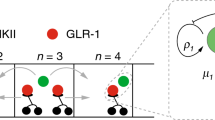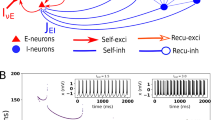Abstract
The probability of long-range connection among neurons could be changeable in biological neuronal networks. In this paper, the probability of long-range connection between neurons is not fixed at a constant but varies in a numerical region (⩽ p 0), and then the collective behaviors of neurons are detected. A statistical factor in the two-dimensional space is used to detect the phase transition and robustness of spiral wave in the active network of neurons. It is found that the development of spatiotemporal pattern depends on the numerical region (⩽ p 0) for the probability of long-range connection. Coherence resonance-like behavior is observed due to the fluctuation in the long-range probability. Spiral waves emerge to occupy the network of neurons under an optimized probability of long-range connection, and it shows certain robustness in weak channel noise.
Similar content being viewed by others
References
Kwon O, Jo H H, Moon H T. Effect of spatially correlated noise on coherence resonance in a network of excitable cells. Phys Rev E, 2005, 72: 066121
Bassett D, Bullmore E. Small-world brain networks. Neurosci, 2006, 12: 512–523
Park C H, Kim S Y, Kim Y H, et al. Comparison of the small-world topology between anatomical and functional connectivity in the human brain. Physica A, 2008, 387(23): 5958–5962
Newman M E, Watts D J. Renormalization group analysis of the small-world network model. Phys Lett A, 1999, 263: 341–346
Newman M E, Watts D J. Scaling and percolation in the small-world network model. Phys Rev E, 1999, 60: 7332–7342
Yuan W J, Luo X S, Wang B H, et al. Excitation properties of the biological neurons with side-inhibition mechanism in small-world networks. Chin Phys Lett, 2006, 23(11): 3115–3118
Yuan W J, Luo X S, Yang R H. Stochastic resonance in neural systems with small-world connections. Chin Phys Lett, 2007, 24(3): 835–838
Perc M. Stochastic resonance on excitable small-world networks via a pacemaker. Phys Rev E, 2007, 76: 066203
Perc M. Stochastic resonance on paced genetic regulatory small-world networks: Effects of asymmetric potentials. Eur Phys J B, 2009, 69: 147–153
Wang M S, Hou Z H, Xin H W. Ordering spatiotemporal chaos in small-world neuron networks. ChemPhysChem, 2006, 7: 579–582
Perc M. Effects of small-world connectivity on noise-induced temporal and spatial order in neural media. Chaos Solitons Fractals, 2007, 31: 280–291
Sun X J, Lei J Z, Perc M, et al. Effects of channel noise on firing coherence of small-world Hodgkin-Huxley neuronal networks. Eur Phys J B, 2011, 79: 61–66
Sun X J, Perc M, Lu Q S, et al. Spatial coherence resonance on diffusive and small-world networks of Hodgkin-Huxley neurons. Chaos, 2008, 18: 023102
Perc M. Spatial decoherence induced by small-world connectivity in excitable media. New J Phys, 2005, 7: 252
Roxin A, Riecke H, Solla S A. Self-sustained activity in a small-world network of excitable neurons. Phys Rev Lett, 2004, 92: 198101
Shanahan M. Dynamical complexity in small-world networks of spiking neurons. Phys Rev E, 2008, 78: 041924
Wang X F, Chen G R. Synchronization in small-world dynamical networks. Int J Bifurcat Chaos, 2002, 12: 187–192
Wang Q Y, Lu Q S. Phase synchronization in small world chaotic neural networks. Chin Phys Lett, 2005, 22(6): 1329–1332
Zheng Y H, Lu Q S. Spatiotemporal patterns and chaotic burst synchronization in a small-world neuronal network. Physica A, 2008, 387: 3719–3728
Wang Q Y, Duan Z S, Perc M, et al. Synchronization transitions on small-world neuronal networks: Effects of information transmission delay and rewiring probability. EPL, 2008, 83: 50008
Han F, Lu Q S, Wiercigroch M, et al. Complete and phase synchronization in a heterogeneous small-world neuronal network. Chin Phys B, 2009, 18(2): 0482–0488
Wang Q Y, Perc M, Duan Z S, et al. Impact of delays and rewiring on the dynamics of small-world neuronal networks with two types of coupling. Physica A, 2010, 389: 3299–3306
Percha B, Dzakpasu R, Żochowski M. Transition from local to global phase synchrony in small world neural network and its possible implications for epilepsy. Phys Rev E, 2005, 72: 031909
Cao Z J, Li P F, Zhang H, et al. Turbulence control with local pacing and its implication in cardiac defibrillation. Chaos, 2007, 17: 015107
Deng L Y, Zhang H, Li Y Q. Resonant drift of two-armed spirals by periodic advective field and periodic modulation of excitability. Phys Rev E, 2010, 81: 016204
Zhan M, Zou W, Liu X. Taming turbulence in the complex Ginzburg-Landau equation. Phys Rev E, 2010, 81: 036211
Luo J M, Zhang B S, Zhan M. Frozen state of spiral waves in excitable media. Chaos, 2009, 19: 033133
Huang X Y, Troy W C, Yang Q C, et al. Spiral waves in disinhibited mammalian cortex. J Neurosci, 2004, 24: 9897
Schiff S J, Huang X Y, Wu J Y. Dynamical evolution of spatiotemporal patterns in mammalian middle cortex. Phys Rev Lett, 2007, 98: 178102
Wu J Y, Huang X Y, Zhang C. Propagating waves of activity in the neocortex: What they are, what they do. Neuroscientist, 2008, 14: 487
Wang X N, Lu Y, Jiang M X, et al. Attraction of spiral waves by localized inhomogeneities with small-world connections in excitable media. Phys Rev E, 2004, 69: 056223
He D H, Hu G, Zhan M, et al. Pattern formation of spiral waves in an inhomogeneous medium with small-world connections. Phys Rev E, 2002, 65: 055204
Sinha S, Saramäki J, Kaski K. Emergence of self-sustained patterns in small-world excitable media. Phys Rev E, 2007, 76: 015101
Qian Y, Huang X D, Hu G, et al. Structure and control of self-sustained target waves in excitable small-world networks. Phys Rev E, 2010, 81: 036101
Ma J, Yang L J, Wu Y, et al. Spiral wave in the small-world networks of Hodgkin-Huxley neurons. Commun Theor Phys, 2010, 54: 583–588
Ma J, Jia Y, Wang C N, et al. Transition from spiral wave to target wave and other coherent structures in the networks of Hodgkin-Huxley neurons. Appl Math Comput, 2010, 217: 3844–3852
Hodgkin A L, Huxley A F. A quantitative description of membrane current and its application to conduction and excitation in nerve. J Physiol-London, 1952, 117: 500–544
Liu F, Hu B B, Wang W. Effects of correlated and independent noise on signal processing in neuronal systems. Phys Rev E, 2001, 63: 031907
Liu F, Yu Y G, Wang W. Signal-to-noise ratio gain in neuronal systems. Phys Rev E, 2001, 63: 051912
Fox R F, Lu Y N. Emergent collective behavior in large numbers of globally coupled independently stochastic ion channels. Phys Rev E, 2004, 49: 3421
Chow C C, White J A. Spontaneous action potentials due to channel fluctuations. Biophys J, 1996, 71: 3013–3021
White J A, Rubinstein J T, Kay A R. Channel noise in neurons. Trends Neurosci, 1996, 23: 131–137
Ma J, Huang L, Ying H P, et al. Spiral wave death, breakup induced by ion channel poisoning on regular Hodgkin-Huxley neuronal networks. Commun Nonlinear Sci Numer Simulat, 2012, 17: 4281–4293
Ma J, Hou Z H, Xin H W. Control coherence resonance by noise recycling. Eur Phys J B, 2009, 69: 101–107
Hou Z H, Xin H W. Noise-sustained spiral waves: Effect of spatial and temporal memory. Phys Rev Lett, 2002, 89: 280601
Wang C N, Ma J, Tang J. Instability and Death of spiral wave in a two-dimensional array of Hindmarsh-Rose neurons. Commun Theor Phys, 2010, 53: 382–388
Author information
Authors and Affiliations
Corresponding author
Rights and permissions
About this article
Cite this article
Ma, J., Wu, Y., Wu, N. et al. Detection of ordered wave in the networks of neurons with changeable connection. Sci. China Phys. Mech. Astron. 56, 952–959 (2013). https://doi.org/10.1007/s11433-013-5070-0
Received:
Accepted:
Published:
Issue Date:
DOI: https://doi.org/10.1007/s11433-013-5070-0




